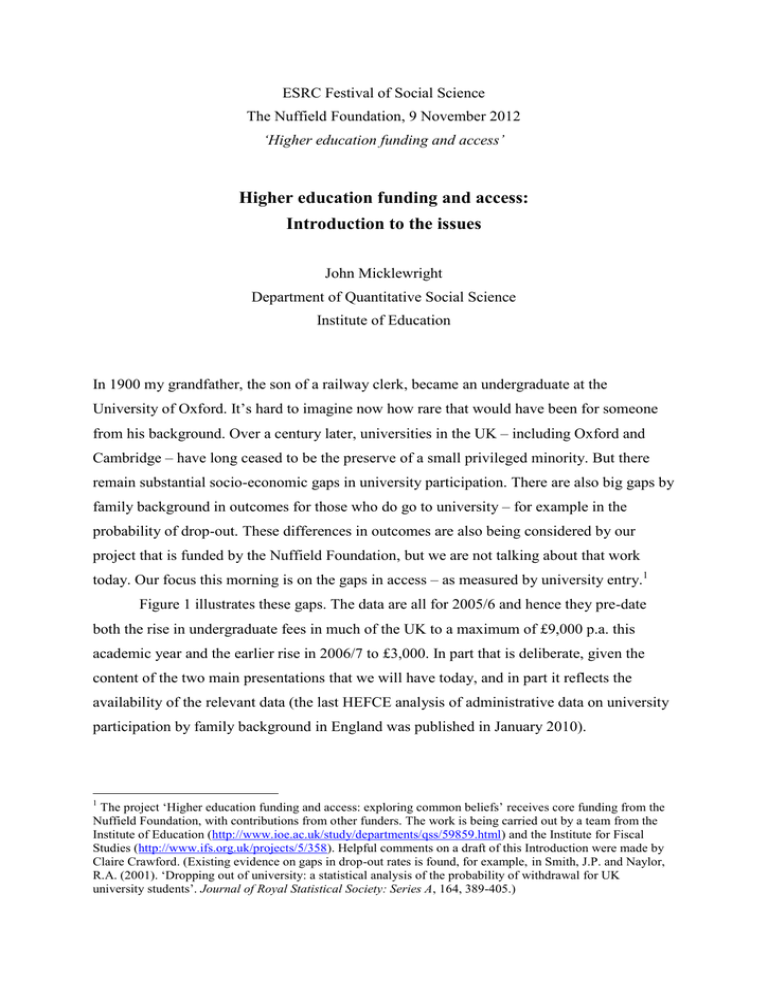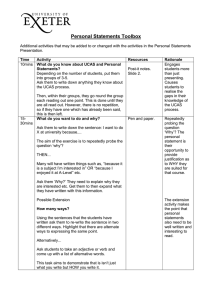Higher education funding and access: Introduction to the issues
advertisement

ESRC Festival of Social Science The Nuffield Foundation, 9 November 2012 ‘Higher education funding and access’ Higher education funding and access: Introduction to the issues John Micklewright Department of Quantitative Social Science Institute of Education In 1900 my grandfather, the son of a railway clerk, became an undergraduate at the University of Oxford. It’s hard to imagine now how rare that would have been for someone from his background. Over a century later, universities in the UK – including Oxford and Cambridge – have long ceased to be the preserve of a small privileged minority. But there remain substantial socio-economic gaps in university participation. There are also big gaps by family background in outcomes for those who do go to university – for example in the probability of drop-out. These differences in outcomes are also being considered by our project that is funded by the Nuffield Foundation, but we are not talking about that work today. Our focus this morning is on the gaps in access – as measured by university entry.1 Figure 1 illustrates these gaps. The data are all for 2005/6 and hence they pre-date both the rise in undergraduate fees in much of the UK to a maximum of £9,000 p.a. this academic year and the earlier rise in 2006/7 to £3,000. In part that is deliberate, given the content of the two main presentations that we will have today, and in part it reflects the availability of the relevant data (the last HEFCE analysis of administrative data on university participation by family background in England was published in January 2010). 1 The project ‘Higher education funding and access: exploring common beliefs’ receives core funding from the Nuffield Foundation, with contributions from other funders. The work is being carried out by a team from the Institute of Education (http://www.ioe.ac.uk/study/departments/qss/59859.html) and the Institute for Fiscal Studies (http://www.ifs.org.uk/projects/5/358). Helpful comments on a draft of this Introduction were made by Claire Crawford. (Existing evidence on gaps in drop-out rates is found, for example, in Smith, J.P. and Naylor, R.A. (2001). ‘Dropping out of university: a statistical analysis of the probability of withdrawal for UK university students’. Journal of Royal Statistical Society: Series A, 164, 389-405.) Figure 1. University participation rates by family background, 2005/6 Free School Meals receipt % of children in local area with graduate parents % of children in local area who are in low income families yes 13 no 33 bottom fifth 17 top fifth 54 top fifth 21 bottom fifth 48 0 10 20 30 40 50 per cent entering university 60 Notes: The figures for participation by Free School Meals receipt refer to the UK. The figures based on the two local area indicators refer to England and show the percentage of 18-19 year olds who enter university in two groups of local areas, those in the bottom and top fifths of the distribution of all local areas ranked on the indicator concerned. Sources: BIS, Widening Participation in Higher Education, August 2012, Table 1 (Free School Meals); HEFCE Trends in young participation in higher education: core results for England, January 2010/03, Figures 19 and 23 (estimates from line graphs). The gap in university participation between teenagers who received Free School Meals and other teenagers shows a striking difference – 20 percentage points. This gap is a much cited statistic but it has the disadvantage of being based on data that lump together the great majority of teenagers who do not receive Free School Meals – only about 15% of pupils in state schools receive this low income benefit. The other two indicators in the graph allow for more gradation in family background, at the cost of moving to measures that refer not to individual characteristics, but to the characteristics of the local area where a young person’s family lives. (The data in these cases refer to England only.) Those young people living in the top fifth of areas when ranked by the percentage of children with at least one parent with a degree (measured at the 2001 Census) had a participation rate in higher education in 2005/6 of 54%, 37 percentage points higher than that of young people living in the bottom fifth of areas ranked on the same measure. The gaps are almost as striking across the distribution of local areas when ranked by the percentage of families receiving low income state benefits 2 (the Income Deprivation Affecting Children Index, or IDACI): participation rates of 48% for young people in the bottom fifth of areas – those with the lowest rates of benefit receipt – and 21% for families in the top fifth of areas with the highest rates of receipt. Figure 1 refers to entry to any university. There are also marked differences by family background in the probability of entering the most selective/prestigious universities and other universities, conditional to going to university at all.2 These are considered by Claire Crawford in her presentation later today. The UK is of course very far from being alone in having these sorts of large gaps in university participation by family background. They are found across the rich industrialised countries of the OECD.3 As part of our Nuffield Foundation project and with the help of British Academy funding, my IOE colleagues John Jerrim and Anna Vignoles have started to make a detailed comparison of gaps in England with those in the USA, Canada, and Australia. The reforms to higher education funding introduced this academic year, notably the sharp increase in the maximum undergraduate fee in most of the UK, has led to much concern that young people from less advantaged family backgrounds will be deterred from applying to university, notwithstanding the favourable terms of the loans on offer and the bursaries available for low income families. Our project focuses on England and it is here that the concern has been greatest.4 From 2012/13, people applying to university who are resident in England face a maximum fee of £9,000, irrespective of where they go to university in the UK. (The year before, 2011/12, the maximum for them was £1,820 if applying to a university in Scotland and £3,375 elsewhere.) However, the maximum faced by people resident in other parts of the kingdom differs notably, depending on where they live and where they apply to. This makes comparison of recent trends in applications in England with those in the other home nations of considerable interest – with the hope that the trends elsewhere are 2 For example, the low numbers of young people who receive Free School Meals and who go to Oxford or Cambridge has been the subject of heated discussion. See House of Commons Debates, 12 January 2011, column c371W, and http://www.guardian.co.uk/education/2011/mar/07/oxford-diversity-free-school-meals. The HEFCE and BIS analysis used in Figure 1 do not give breakdowns of participation rates by both university ‘quality’ and socio-economic background. 3 See, for example, OECD, Education at a Glance 2012: OECD Indicators, Table A6.1, which gives a comparison of university participation of young people by parental education for 33 countries. 4 Our focus on England is in large part on grounds of data availability – sources such as the National Pupil Database and the Longitudinal Study of Young People in England do not cover other parts of the UK. (We recognise that other parts of the UK also have rich data sources but they are not always easily compared with those for England.) 3 informative on what might have happened in England had the rise in fees there not taken place.5 Figure 2 compares application rates to higher education for 18 year olds resident in England with those for young people of the same age resident in Wales and in Scotland. These rates are estimated by UCAS for entry in the years 2004/5 to 2012/3. Entry in the last of these years is at the new maximum level of fees.6 (The UCAS analysis also covers Northern Ireland but the points I make below are illustrated sufficiently well with the data for Great Britain only.) Figure 2. Application rates to UK universities of 18 year olds by country of domicile 40 England 35 Scotland 30 Wales 25 % 20 15 10 5 0 2004 2005 2006 2007 2008 2009 2010 2011 2012 Source: UCAS, How have applications for full-time undergraduate higher education in the UK changed in 2012?, July 2012, Figure 13. 5 In other words, there is the potential for using the method of ‘difference in differences’ (DiD) to evaluate the impact of the fee rise in England on the application rate. There is not the time in this Introduction to go into all the issues that would arise in the use of DiD in this context. 6 The Independent Commission on Fees has re-analysed the data provided by UCAS and finds trends in applicant numbers (as distinct from rates) are similar when 18 and 19 year olds are taken together, that is including applications made by the latter during a gap year (Independent Commission on Fees, Analysis of UCAS applications for 2012/13 admissions, August 2012.) 4 Wales is of particular interest as university applicants from this country have seen almost no change in the maximum fee in 2012/13. Welsh universities will charge applicants from Wales a maximum of £3,465 p.a and the Welsh Government will pay the difference above this level of fee for study at a university in any other part of the UK. The rise in the maximum fee of just £90 in 2012/3 for applicants from Wales represents merely a continuation of an inflation adjustment to the maximum of £3,000 introduced in 2007/8 (a year later than in England).7 This means that there has been no major change in fees for Welsh applicants (applicants from Wales) during the major economic downturn suffered by the UK since 2007 – the ‘Great Recession’, the largest contraction in output since the interwar period. We need to consider the possible impact of the Great Recession on recent trends in application rates, at the same time as thinking about any impact of the changes in fees.8 For young people in England the impact of the two influences will be confounded in the data on university applications while for Welsh applicants there should be little or no impact of the very modest changes in fees. (Of course, there may be other influences as well that have affected the recent trends and these could differ across the different parts of the UK.) Scotland is also a good comparator. Young people from Scotland faced no fee at all for entry in either 2011/12 or 2012/13 if they went to a Scottish university. If they went to university elsewhere in the UK they faced a maximum fee of £3,375 p.a. for entry in 2011/12 and now £9,000 p.a. in 2012/13. So as in Wales, Scotland has not had the sharp rise in fees seen in England. When we look at the change in application rates for young people from Scotland between 2011/12 and 2012/13 shown by Figure 2, we do of course need to be aware that the impact of the increase in the ‘out-of-Scotland’ maximum will be reflected in the data (if changes in fees do in fact affect applications). However, throughout the nine year period covered by Figure 2, the vast majority of university applications by young people from Scotland have in fact been to Scottish universities – around 95% – so in practice we would expect the rise in fees for applications to universities elsewhere in the UK to have little effect on the overall application rate for Scotland shown in the graph. 7 The changes in maximum fees in Wales have been somewhat more complicated than I present here. For a careful account of changes in fees in England, Wales, and Scotland and their possible impact on applications, see J. Thompson and B. Bekhradnia, The impact on demand of the Government's reforms of higher education, Higher Education Policy Institute, November 2012. The authors provide a more detailed analysis of recent trends than I do in this note. 8 Economic theory is ambiguous on the direction of the impact that a downturn in the labour market may have on staying on in full-time education. (See e.g. Levhari, D. and Y. Weiss (1974) ‘The Effect of Risk on the Investment of Human Capital’, American Economic Review, 64 (4), 950-963, Kodde, D. (1988) ‘Unemployment expectations and human capital formation’ European Economic Review 32(8), 1645-1660, and Micklewright, J., Pearson, M. And Smith, S. (1990) ‘Unemployment and early school leaving’ Economic Journal, 100, S163-9. ) 5 The graph shows the application rate rising in all three cases – England, Scotland, and Wales – across the nine year period. But in the case of England, our focus, the rate fell in 2012 (i.e. for entry in 2012/13), from 35.4% in the year before to 34.2%, whereas the data show no falls for Wales or Scotland.9 It is notable that there was a fall of a similar magnitude (one percentage point) in England in 2006 (i.e. for entry in 2006/7) at the time of the introduction of variable fees, which included a rise to a maximum of £3,000 (from the fixed fee of £1,000 the year before). However, neither of these falls is large compared to the year on year increases, or the change over the period as a whole – a rise of 6.8 percentage points. It would be very premature to conclude with any certainty that the falls in England were caused by the rise in fees. In both cases, the falls in 2012 and 2006 are preceded by rises in application rates in the previous year. Those rises could represent a reaction by young people who would otherwise have taken a gap year – bringing forward their application for entry by a year so as to avoid the announced rise in fees. Or they could have just represented a continuation of an earlier trend of rising applications. The UCAS analysis of the data comes down in favour of the latter explanation.10 For an alternative view, see the November 2012 report from the Higher Education Policy Institute.11 There is keen interest in how application rates have changed by family background at around the time of the major fee increases. Is there any evidence of a larger fall in the rate in 2012 for more disadvantaged families? Figure 3 shows application rates for 18 year olds in England, classified according to percentage of families receiving low income state benefits in the local area in which the young person lives. The series at the top of the graph is for those 18 year olds in the areas with the lowest rates of benefit receipt – the least deprived areas – and the series at the bottom is for those in the areas with the highest rates of receipt – the most deprived areas. The large difference between the two series drives most of the gap in university attendance by the same measure (local area IDACI) shown earlier in Figure 1. 12 But our interest now is in the changes over time in each series. It is notable that the largest falls in both 2006 and 2012 are for young people from the least deprived areas (2.6 and 1.8 9 Analysis by UCAS of the separate ‘within-Scotland’ and ‘out-of-Scotland’ application rates of young people from Scotland do in fact show the latter dipping in 2012/13, as in England . UCAS (2012) How have applications for full-time undergraduate higher education in the UK changed in 2012?, Figure 16. 10 Ibid, para 62. Paras 84-90 in the UCAS reports describes the trends in application rates for 19 year olds and for older age groups. 11 See footnote 7. 12 The differences in application rates as the main driver of differences in the socio-economic gap in attendance is underlined by work from our project using the Longitudinal Study of Young People in England: Anders, J (2012) ‘The link between household income, university applications and university attendance’, Fiscal Studies, 33 (2): 185-210 6 percentage points respectively) while the application rates for those from the most deprived areas show no fall in 2006 and a fall of only 0.1 percentage points in 2012. On the face of it, there is no simple story supported by the data of a dropping off in applications being concentrated in families from low income areas. Figure 3. English 18 year old application rates for local areas grouped by quintiles of the % of children in the local area who are in low income families 60 50 Q5 Q4 40 Q3 % 30 Q2 Q1 20 10 0 2004 2005 2006 2007 2008 2009 2010 2011 2012 Note: the graph shows application rates by quintile groups of local areas ranked by the percentage of children living in low income households (as measured by IDACI). Q5 is the the group with the lowest percentage. Source: UCAS, How have applications for full-time undergraduate higher education in the UK changed in 2012?, July 2012, Figure 18. This concludes my quick tour of some of the background to discussion of university access in England to prepare the way for the two main presentations this morning. Our first presentation, by Claire Crawford, looks back at the rise in tuition fees in 2006/7 to investigate in detail how it affected the relationship between university entry (note, not just application) and family background – both entry to any university and entry to high 7 status institutions. Claire exploits data on successive cohorts of teenagers from the National Pupil Database that have been linked to Higher Education Statistics Agency records which show whether each young person has actually gone to university or not. Her data span the change in fees in 2006/7. In doing so, she is also able to shed much light on why there is such a big socio-economic gap in university participation in England. Does it come just at the point of application to university – or do the origins lie much further back in the teenage years or even earlier in childhood? Our second presentation, of work by Haroon Chowdry, Lorraine Dearden, Michelle Jin, and Barnaby Lloyd delves into the levels of fees that young people from disadvantaged backgrounds now really do face when applying to university. The maximum fee for entry in 2012 that I have referred to, e.g. £9,000 for all applicants from England, is just that, a maximum. The so-called ‘sticker’ price of university attendance – as the US literature has called the gross fees – varies to some extent by the subject to be studied and by university.13 But we also need to take account of the bursaries available for low income families and other measures that universities wishing to charge more than £6,000 must agree with the Office for Fair Access. For the first time, the research by Chowdry, Dearden, Jin, and Lloyd investigates how the net prices for university entry in the UK – the ‘real’ cost of university – vary by family background. This is vital evidence for any discussion of how the recent rises in fees may have affected university participation amongst disadvantaged groups. 13 The variation is analysed by UCAS, ibid, paras 114-127. 8





